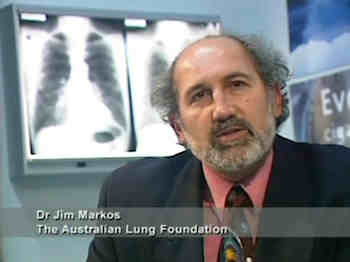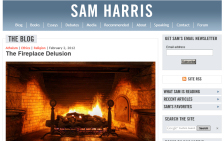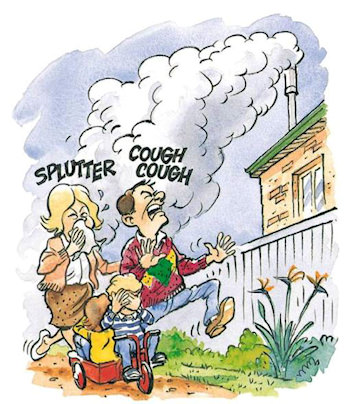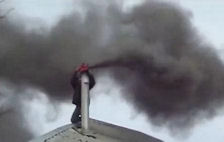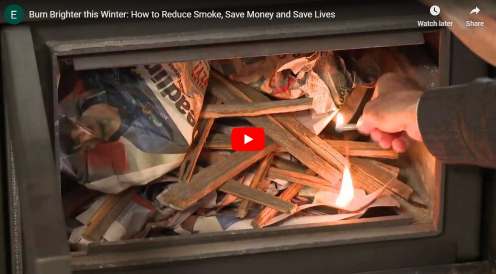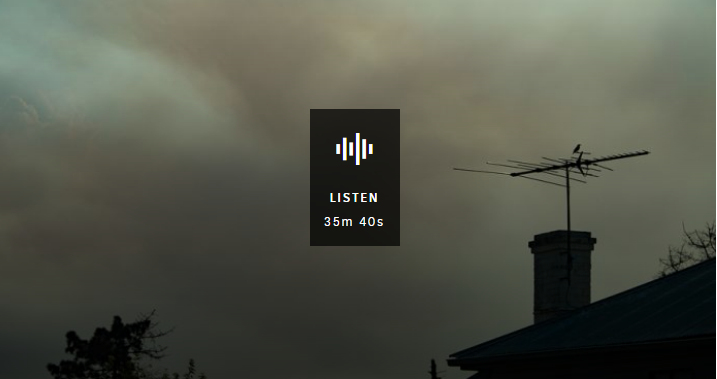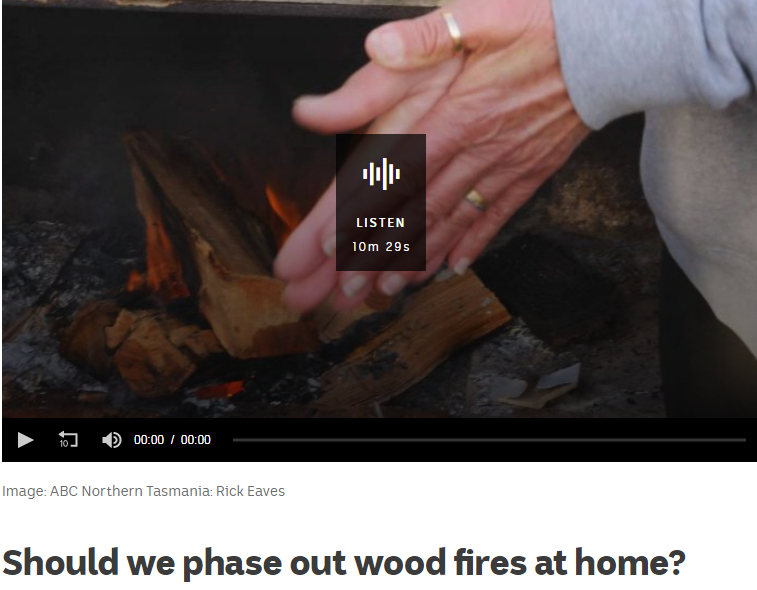"Wood heater smoke contains fine particles and toxic chemicals including cancer causing
compounds.
Any material floating about in the air can be breathed into our bodies. While some of the particles are
exhaled, a fraction is retained and these can have adverse impacts on our health.
Most at risk are the young, the elderly or those people who sufferer from bronchitis, emphysema,
asthma, and other lung or heart diseases.
There is also evidence that fine particle matter can lead to premature deaths.
Especially at risk are elderly people who suffer from chronic respiratory problems.
Everybody has a responsibility to help keep our air clean. If you can see or smell smoke then you are
causing a problem for yourself, your family and your neighbours." - WA Department of Environment and
It has been easy for the forestry industries to blame wood heaters in the past for smoking
communities out, even though forestry put 32 times as many particulates into our Tasmanian air shed.
The number of wood heaters installed has diminished significantly as a result of, for example, the
wood heater buy-back program, but smoke levels are still unacceptable across some locations in
Tasmania during the colder months of the year.
Can you imagine how terrible it must be to live next to a smoky flue?
It is important for people to be warm and for their houses to be mould free - especially asthmatics.
Wood heaters, if used properly and considerately, play their part in helping to achieve this when other
clean forms of heating are not possible for whatever reason.
In Tasmania we need home heating for about 6 months of the year. We certainly do not need wood
heater smoke for 6 months of the year!
The current emissions standard for a wood heater is 4gms of particulates for every 1Kg of dry
wood burnt.
Certified wood heaters are tested under laboratory conditions which do not equate to real-life
conditions.
Read below how air quality inside a Tasmanian home was seriously compromised by the
operation of a wood heater.
Go here to read COAG's Consultation Regulation Impact Statement.
Go here to read the cleanairtas submission.
Go here to read all the submissions
Councils manage smoke from wood heaters. Go here to see how councils and the EPA differ on
who is meant to be responsible for administering the Environment Act and Regulations in Tasmania.
Domestic Pellet Heating in Tasmania 7th March 2012. Go here to read the facts.
Island Bio-Energy say bulk deliveries of pellets will be available next season once reserves have been
built up.
Annual average fuel consumption is about a tonne (66Kg bags) which compares to about four or five
tonnes of firewood to heat a typical Tasmanian home - Sunday Tasmanian - Winter heating feature May 12,
2013.
Go here to read the Department of Sustainability, Environment, Water, Population and Communities
pages on wood heaters
Go here to watch further video presentations on wood heater smoke by:
Dr Fay Johnston, GP and Tasmanian Senior Researcher Menzies Research Institute,
Dr John Innis, Senior Environmental Officer, Air, EPA Tasmania,
Professor John Todd, Academic and Consultant, Tasmania.
If you must burn go here to find a fighlighter that does not stink and lights easily.
Go here to read what the Australian Home Heating industry had to say on June 1, 2005
In August 2013 a Senate Inquiry in Australia found AHHA's claims were untrue.
'Wood heater' also known as a 'wood hater' or 'wood eater'
Wood heater, fire place, back yard burn, incinerator and fire pit smoke is like any other smoke...
it is toxic, harmful, and can be deadly.
2008 - There is no such thing as a certified wood heater installer in Tasmania and other approved certification bodies do not want to be involved.
There is no current inventory to show the location or number of wood heaters installed in Tasmania.
Question to EPA regarding 2016 Australian Census and wood heater numbers
Submissions for the 2021 Australian Census open in October/November 2017
Wood heater, fire place, back yard burn, incinerator and fire pit smoke is like any other smoke...
it is toxic, harmful, and can be deadly.
2008 - There is no such thing as a certified wood heater installer in Tasmania and other approved certification bodies do not want to be involved.
There is no current inventory to show the location or number of wood heaters installed in Tasmania.
Question to EPA regarding 2016 Australian Census and wood heater numbers
Submissions for the 2021 Australian Census open in October/November 2017
Dr. Jim Markos, Tasmanian medical lung specialist (Australian Lung Foundation)
Dr. Sverre Vedal of the University of Washington
Dr. Michael Aizen, Tasmanian, from the Australian Medial Association.
When you can't breathe, nothing else matters.
Click on the picture to watch the video.
Dr. Sverre Vedal of the University of Washington
Dr. Michael Aizen, Tasmanian, from the Australian Medial Association.
When you can't breathe, nothing else matters.
Click on the picture to watch the video.
Doctors speak up against wood heater smoke
Click on the above picture to read Sam Harris's
The Fireplace Delusion.
The Fireplace Delusion.

Wood heaters and fire places.
Back yard burns, incinerators, fire pits
Back yard burns, incinerators, fire pits
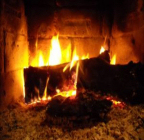
Go here to watch EPA YouTube wood heater wood smoke videos
"What happens in your chimney doesn't stay in your chinmey" - Dr. Brian Moench, President of Utah Physicians for a Healthy Environment.
"What happens in your chimney doesn't stay in your chinmey" - Dr. Brian Moench, President of Utah Physicians for a Healthy Environment.
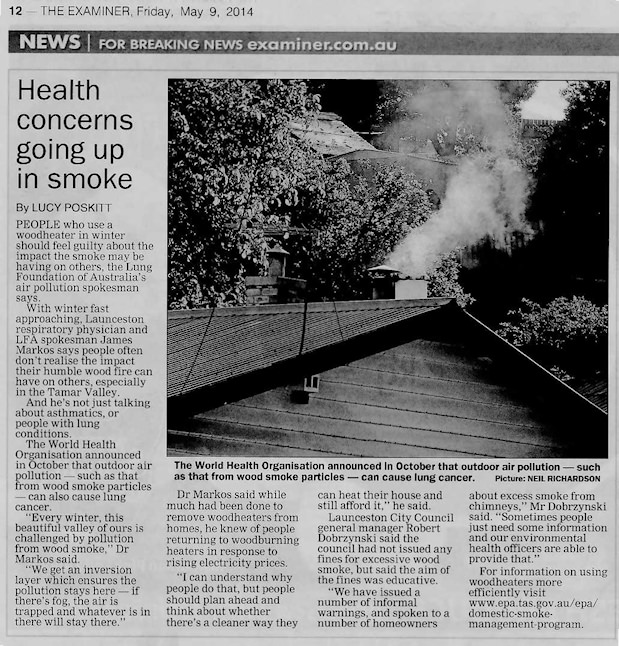
Menzies Research Institute Tasmania / UTAS - 2014 projects (.pdf file here)
Fire Box Project - Smart Burn devices being tested in Perth Tasmania (.pdf file here)
Perth residents part of research project.
Read about Perth here. We don't gibbett people in Tasmania anymore, we hasten their death with smoke!
EPA real-time air quality results can be read for Perth here.
Read the results of the Perth (Tas) smartburn research project here and here.
There was a previous SmartBurn study done in Armidale, NSW - see below:
Fire Box Project - Smart Burn devices being tested in Perth Tasmania (.pdf file here)
Perth residents part of research project.
Read about Perth here. We don't gibbett people in Tasmania anymore, we hasten their death with smoke!
EPA real-time air quality results can be read for Perth here.
Read the results of the Perth (Tas) smartburn research project here and here.
There was a previous SmartBurn study done in Armidale, NSW - see below:
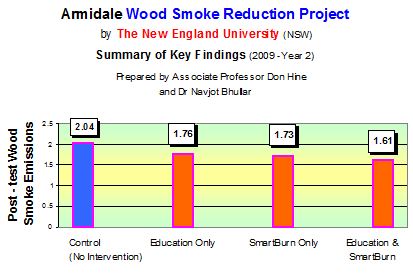
The Environmental Management and Pollution Control (Distributed Atmospheric Emissions) Regulations 2007 and now 2017, also known as the DAE Regulations, are used to regulate wood heaters and backyard burning in Tasmania. You can access the DAE Regulations HERE.
You will notice our Regulations lapsed in early 2019 so at present we do not have any 'domestic' Smoke Regulations.
You can read about the Compliance Policy HERE
The EPA's position on the sale/disposal of old, non-compliant, 2nd wood heaters can be found HERE.
Check your wood heater has a compliance plate attached stating it conforms to the Australian Standard for pollution emissions (AS/NZS 4013:2014) and efficiency (AS/NZS 4012:2014).
You will notice our Regulations lapsed in early 2019 so at present we do not have any 'domestic' Smoke Regulations.
You can read about the Compliance Policy HERE
The EPA's position on the sale/disposal of old, non-compliant, 2nd wood heaters can be found HERE.
Check your wood heater has a compliance plate attached stating it conforms to the Australian Standard for pollution emissions (AS/NZS 4013:2014) and efficiency (AS/NZS 4012:2014).
Shirley Brandie - A victim of wood smoke pollution. Read her story here
June 27, 2014 Wood Fire Heaters: The Hidden Killer - Sydney Morning Herald
Cleaning a chimney the Russian way - click on the photo
A woodsmoke health message
Here is a short Youtube video from Tasmania that applies all around the world.
Here is a short Youtube video from Tasmania that applies all around the world.
A case study of how air quality readings can rise to dangerous levels inside a house when a wood heater is lit:
A well-known approved brand (compliance test plate attached) 250 square meter rated, free-standing wood heater (1.6gm/h emissions, 61% efficiency) was installed and smoke smell was reported inside the house.
The installer checked the flue and the retailer checked the heater. Despite this, the smoke smell inside the house continued.
It was agreed the owner would run a laser particle counter in the vicinity (3 to 4 feet) of the heater for some time prior to the retailer and installer coming back together. The readings were noted and would later be compared in their presence after the heater was lit.
No smoke spilled from the wood heater on lighting.
A few minutes after firing, the smoke smell was immediately obvious. For brevity just the 'lighting stage' of the particle counts is listed below...
The particle counts did not drop back to what they were before the heater was lit until after the heater ran out of fuel.
Needless to say the wood heater, two story flue kit and installation costs were fully refunded to the owner by the heater manufacturer after the heater was removed by the installer and returned to the retailer.
Date Time 0.5micron 2.5micron
07/02/14 17:05, 874, 82
07/02/14 17:06, 892, 59
07/02/14 17:07, 865, 74
07/02/14 17:08, 883, 75
07/02/14 17:09, 943, 90
07/02/14 17:10, 933, 100
07/02/14 17:11, 976, 101 -----Wood heater was lit.
07/02/14 17:12, 966, 101
07/02/14 17:13, 979, 98
07/02/14 17:14, 989, 107
07/02/14 17:15, 1030, 125
07/02/14 17:16, 4843, 129
07/02/14 17:17, 14572, 178
07/02/14 17:17, 15417, 203
07/02/14 17:18, 28974, 310
07/02/14 17:19, 41396, 419
07/02/14 17:20, 50964, 644
07/02/14 17:21, 50594, 633
07/02/14 17:22, 55492, 761
07/02/14 17:23, 49740, 537
07/02/14 17:24, 47197, 452
07/02/14 17:25, 47637, 467
07/02/14 17:26, 48193, 474
07/02/14 17:27, 48643, 513
07/02/14 17:28, 51608, 582
07/02/14 17:29, 49823, 565
07/02/14 17:30, 48430, 686
07/02/14 17:31, 49885, 714
Cleanairtas has consistently argued that our wood heater approval standards must state that zero emissions are to occur in the vicinity of a wood heater during certification testing and at the property boundary. Theses dynamic tests should also be mandatory after any wood heater is installed.
Car makers wouldn't be allowed to inject car fumes directly into the vehicle cabin would they?
Download this article here
A well-known approved brand (compliance test plate attached) 250 square meter rated, free-standing wood heater (1.6gm/h emissions, 61% efficiency) was installed and smoke smell was reported inside the house.
The installer checked the flue and the retailer checked the heater. Despite this, the smoke smell inside the house continued.
It was agreed the owner would run a laser particle counter in the vicinity (3 to 4 feet) of the heater for some time prior to the retailer and installer coming back together. The readings were noted and would later be compared in their presence after the heater was lit.
No smoke spilled from the wood heater on lighting.
A few minutes after firing, the smoke smell was immediately obvious. For brevity just the 'lighting stage' of the particle counts is listed below...
The particle counts did not drop back to what they were before the heater was lit until after the heater ran out of fuel.
Needless to say the wood heater, two story flue kit and installation costs were fully refunded to the owner by the heater manufacturer after the heater was removed by the installer and returned to the retailer.
Date Time 0.5micron 2.5micron
07/02/14 17:05, 874, 82
07/02/14 17:06, 892, 59
07/02/14 17:07, 865, 74
07/02/14 17:08, 883, 75
07/02/14 17:09, 943, 90
07/02/14 17:10, 933, 100
07/02/14 17:11, 976, 101 -----Wood heater was lit.
07/02/14 17:12, 966, 101
07/02/14 17:13, 979, 98
07/02/14 17:14, 989, 107
07/02/14 17:15, 1030, 125
07/02/14 17:16, 4843, 129
07/02/14 17:17, 14572, 178
07/02/14 17:17, 15417, 203
07/02/14 17:18, 28974, 310
07/02/14 17:19, 41396, 419
07/02/14 17:20, 50964, 644
07/02/14 17:21, 50594, 633
07/02/14 17:22, 55492, 761
07/02/14 17:23, 49740, 537
07/02/14 17:24, 47197, 452
07/02/14 17:25, 47637, 467
07/02/14 17:26, 48193, 474
07/02/14 17:27, 48643, 513
07/02/14 17:28, 51608, 582
07/02/14 17:29, 49823, 565
07/02/14 17:30, 48430, 686
07/02/14 17:31, 49885, 714
Cleanairtas has consistently argued that our wood heater approval standards must state that zero emissions are to occur in the vicinity of a wood heater during certification testing and at the property boundary. Theses dynamic tests should also be mandatory after any wood heater is installed.
Car makers wouldn't be allowed to inject car fumes directly into the vehicle cabin would they?
Download this article here
Harmful levels of wood heater smoke in a Launceston suburb.
Go here to read EPA BLANkET Technical Report #28
Go here to read EPA BLANkET Technical Report #28
The University of New England project provided the first large-scale field test of SmartBurn
As a result of that study, Prof Don Hine recommended that Council stop
subsidizing smartburns because they did not make much difference.
As a result of that study, Prof Don Hine recommended that Council stop
subsidizing smartburns because they did not make much difference.
Go HERE to read the Tasmanain EPA's pamphlet for Regulations on Wood Heater Emissions
No, it is not the Regulations pamphlet anymore, just it's cover.
No, it is not the Regulations pamphlet anymore, just it's cover.
Go HERE to read the Tasmanian EPA's pamphlet for Regulations on Backyard Burning
The Regulations do not prohibit burning on any land size above 2000 square meters!
2000 sq meters = just half an acre or 0.2 hectare
PM2.5 can travel 1000Km and stay airbourne for weeks!
The Regulations do not prohibit burning on any land size above 2000 square meters!
2000 sq meters = just half an acre or 0.2 hectare
PM2.5 can travel 1000Km and stay airbourne for weeks!
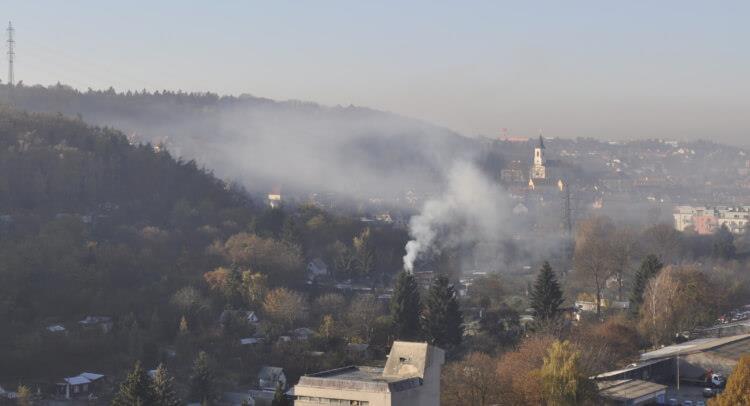
Air pollution from local heating
Wood heaters are not meant to be sold if they do not meet current certification standards.
Here in Tasmania it is common practice to see 2nd hand heaters being advertised for sale that do not comply with
current standards.
And again HERE. Some are about 20 years old. Some have even been welded up/altered by the owners.
These non-complying wood heaters need removing from 'the system'.
It would be easy for the EPA to hit the 'report' link on the advertised site to have this practice stopped.
Here in Tasmania it is common practice to see 2nd hand heaters being advertised for sale that do not comply with
current standards.
And again HERE. Some are about 20 years old. Some have even been welded up/altered by the owners.
These non-complying wood heaters need removing from 'the system'.
It would be easy for the EPA to hit the 'report' link on the advertised site to have this practice stopped.
Health Impacts of Residential Wood Smoke Emissions on Indoor Air Quality - Air Cleaners - UTAS PhD
Study - Effectiveness of indoor air cleaners
Evaluating the effectiveness of a commercial portable air purifier in homes with wood burning stoves
Study - Effectiveness of indoor air cleaners
Evaluating the effectiveness of a commercial portable air purifier in homes with wood burning stoves
No regards for current AS/NZS Wood Heater Efficiency or Emission Standards....
Rob Halton July 29, 2019 at 2:17 pm
"Clive of cause I am still using my 28 year old freestanding Saxon Blackwood re installed with a new flue kit in our North Hobart residence during 2002!
There is absolutely no reason to remove it and I would be proud to suggest it will probably see at least half a century’s faithful service, it has now become a question of me out living the useful life of my woodheater. The woodheater should outlast me!
With proper seasonal flue cleaning and using mainly very dry silver peppermint firewood properly stacked and aerated on the home front sourced from wind felled trees it makes no sense to change my mode of domestic heating.
LONG LIVE SUSTAINABLE DOMESTIC RESIDENTIAL WOOD HEATING for those prepared to maintain the upkeep in a responsible manner!"
https://tasmaniantimes.com/2018/11/96681/#comment-229269
Rob Halton July 29, 2019 at 2:17 pm
"Clive of cause I am still using my 28 year old freestanding Saxon Blackwood re installed with a new flue kit in our North Hobart residence during 2002!
There is absolutely no reason to remove it and I would be proud to suggest it will probably see at least half a century’s faithful service, it has now become a question of me out living the useful life of my woodheater. The woodheater should outlast me!
With proper seasonal flue cleaning and using mainly very dry silver peppermint firewood properly stacked and aerated on the home front sourced from wind felled trees it makes no sense to change my mode of domestic heating.
LONG LIVE SUSTAINABLE DOMESTIC RESIDENTIAL WOOD HEATING for those prepared to maintain the upkeep in a responsible manner!"
https://tasmaniantimes.com/2018/11/96681/#comment-229269
8th August 2019 - Wood heater emissions reduction comes into effect
A limit of 1.5 grams per kilogram dry wood burnt will apply to all new wood heaters.
A limit of 2.5 grams per kilogram came into effect on 8 August 2015
Prior to that it was 4g/Kg
A limit of 1.5 grams per kilogram dry wood burnt will apply to all new wood heaters.
A limit of 2.5 grams per kilogram came into effect on 8 August 2015
Prior to that it was 4g/Kg
Our findings highlight the potential for important public health gains from interventions to reduce ambient pollution from biomass smoke.
Decreased air pollution from ambient biomass smoke was associated with reduced annual mortality in males and with reduced cardiovascular and respiratory mortality during winter months.
Decreased air pollution from ambient biomass smoke was associated with reduced annual mortality in males and with reduced cardiovascular and respiratory mortality during winter months.
Tasmanians are being urged to use wood heaters responsibly to cut down on smoke which can worsen health conditions including asthma and heart disease.
Public Health director Mark Veitch said smoke reduced air quality and affected some people's health.
"The smaller particles in wood smoke can be breathed deeply into our lungs and even enter the bloodstream," Dr Veitch said.
Public Health director Mark Veitch said smoke reduced air quality and affected some people's health.
"The smaller particles in wood smoke can be breathed deeply into our lungs and even enter the bloodstream," Dr Veitch said.
Top Tips to Burn Brighter This Winter
A video by Environment Protection Authority (EPA) Tas.
A good video but is let down when it says,
“Healthy people tend to recover quickly from a smoky neighbourhood”
This is not absolutely true when research shows wood smoke entering our lungs crosses over into our blood stream and carries carcinogenic toxins to other organs, which can suffer in time .
Even healthy people are at risk from breathing wood smoke, not just susceptible groups.
Let us make this clear in 2020
A video by Environment Protection Authority (EPA) Tas.
A good video but is let down when it says,
“Healthy people tend to recover quickly from a smoky neighbourhood”
This is not absolutely true when research shows wood smoke entering our lungs crosses over into our blood stream and carries carcinogenic toxins to other organs, which can suffer in time .
Even healthy people are at risk from breathing wood smoke, not just susceptible groups.
Let us make this clear in 2020
New UTAS study reveals the health damages of wood heater smoke
Led by Menzies Institute PhD student Nicolas Borchers-Arriagada, and supervised by Associate Professor Fay Johnston, this is the first study to estimate the health impacts and associated health costs caused by biomass smoke in Tasmania. The study estimated that in Tasmania the average yearly health costs were $293 million for wood heater smoke. This translates into health costs equivalent to $4,232 per wood heater each year across the state.
Led by Menzies Institute PhD student Nicolas Borchers-Arriagada, and supervised by Associate Professor Fay Johnston, this is the first study to estimate the health impacts and associated health costs caused by biomass smoke in Tasmania. The study estimated that in Tasmania the average yearly health costs were $293 million for wood heater smoke. This translates into health costs equivalent to $4,232 per wood heater each year across the state.
Distribution of wood heaters and open fires in Tasmania
Tasmania’s population exposure to known airborne pollutants is mainly from
particulate matter as a result of wood burning.
Elevated wood smoke-derived particulates are experienced in Tasmania, particularly during the autumn and winter seasons, with the main sources: planned burns,
associated with either land management or hazard reduction; and the burning
of wood for home heating, from either wood heaters or open fires.
Tasmania’s population exposure to known airborne pollutants is mainly from
particulate matter as a result of wood burning.
Elevated wood smoke-derived particulates are experienced in Tasmania, particularly during the autumn and winter seasons, with the main sources: planned burns,
associated with either land management or hazard reduction; and the burning
of wood for home heating, from either wood heaters or open fires.
London Councils have issued zero fines for wood-burning stoves -25/6/2021
In the past five years, London councils have issued no fines for the use of wood-burning stoves Air Quality News can reveal.
In the past five years, London councils have issued no fines for the use of wood-burning stoves Air Quality News can reveal.
Call to phase out wood heaters due to health, environmental concerns, but minister says move not supported by community – ABC 18.6.2021
Up to 40,000 wood heaters are sold in Australia each year.
In Launceston, the city ran a buyback scheme nearly two decades ago that saw up to 2,000 heaters removed from the city and surrounds but it needed $2 million from the federal government.
Dr James Markos was one of the specialist doctors involved in the campaign to reduce smoke in the city.
"It was a real problem. We were seeing an increase in admissions to the hospital in the winter," he said.
The program was ultimately effective, with air pollution falling almost 40 per cent.
Experts estimate there were 28 per cent fewer respiratory-related deaths that winter.
"There's a cohort of people with severe asthma who we have been following for that whole time who are still alive as a result," Dr Markos said.
Up to 40,000 wood heaters are sold in Australia each year.
In Launceston, the city ran a buyback scheme nearly two decades ago that saw up to 2,000 heaters removed from the city and surrounds but it needed $2 million from the federal government.
Dr James Markos was one of the specialist doctors involved in the campaign to reduce smoke in the city.
"It was a real problem. We were seeing an increase in admissions to the hospital in the winter," he said.
The program was ultimately effective, with air pollution falling almost 40 per cent.
Experts estimate there were 28 per cent fewer respiratory-related deaths that winter.
"There's a cohort of people with severe asthma who we have been following for that whole time who are still alive as a result," Dr Markos said.
Why we need transparency in the wood-burning industry
it’s still not common knowledge that wood smoke – whether visible or invisible – is toxic. There is now a wealth of scientific data which links wood-burning emissions to a wide range of diseases including cancers, impaired cognition, stroke, heart disease, asthma, COPD, and reduced lung and brain function in children.
it’s still not common knowledge that wood smoke – whether visible or invisible – is toxic. There is now a wealth of scientific data which links wood-burning emissions to a wide range of diseases including cancers, impaired cognition, stroke, heart disease, asthma, COPD, and reduced lung and brain function in children.
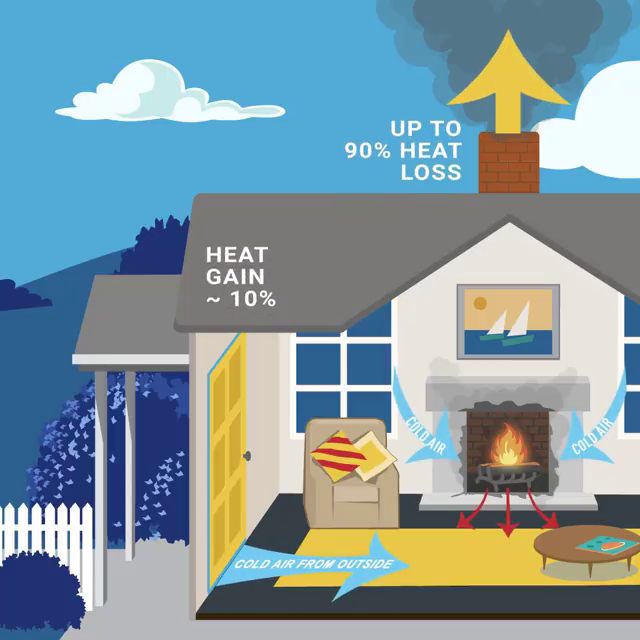
There is up to 90% heat loss up the chimney with an open fire
Association between home insulation and hospital admission rates
This really interesting study found major health benefits of retrofitting insulation in New Zealand (NZ) homes
Warmer, more comfortable homes (thanks to improved insulation) have other advantages.They save lives by reducing the need for wood heating.
In 2005, NZ attempted to solve its pollution problem by introducing stricter wood stove standards than currently required anywhere else in the world. Sadly, the efforts failed. Average real-life emissions of new wood stoves were almost 8 times worse than lab test measurements, with virtually no relationship between real-life and lab test emissions.
This really interesting study found major health benefits of retrofitting insulation in New Zealand (NZ) homes
Warmer, more comfortable homes (thanks to improved insulation) have other advantages.They save lives by reducing the need for wood heating.
In 2005, NZ attempted to solve its pollution problem by introducing stricter wood stove standards than currently required anywhere else in the world. Sadly, the efforts failed. Average real-life emissions of new wood stoves were almost 8 times worse than lab test measurements, with virtually no relationship between real-life and lab test emissions.
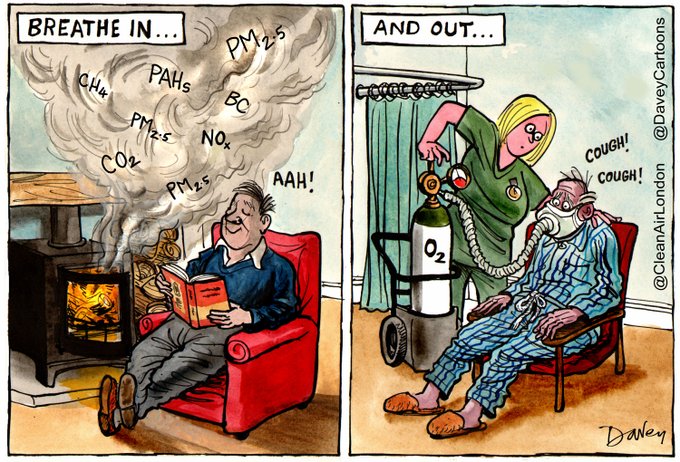
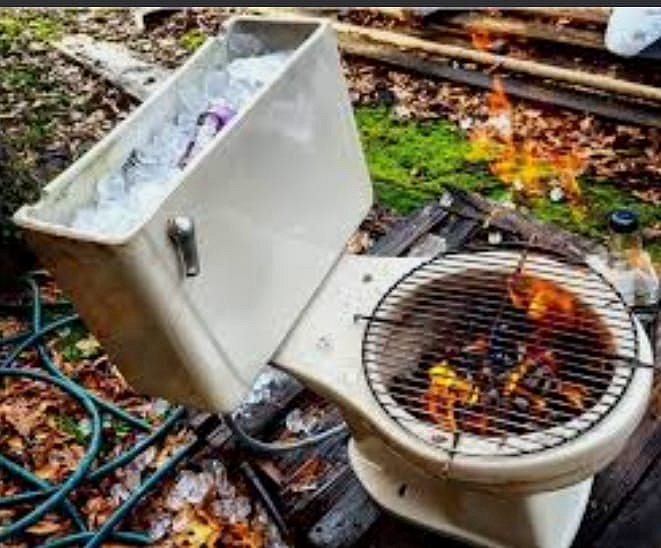
Fire pit
Changing how we heat our homes can benefit both health and climate
Many people who use wood-burning stoves are unaware of the associated health hazards from indoor air pollution, especially for children and older adults. Cleaner, safer forms of domestic heating are now available that provide the added bonus of lower greenhouse gas emissions.
Many people who use wood-burning stoves are unaware of the associated health hazards from indoor air pollution, especially for children and older adults. Cleaner, safer forms of domestic heating are now available that provide the added bonus of lower greenhouse gas emissions.
The killer we invited into our lounge room - ABC Podcast 35Min.
Click on above image
Click on above image
09.05.2022 - The Project -
Network 10 mentions wood fires/heaters (9Mb download)
Network 10 mentions wood fires/heaters (9Mb download)
Tasmanian authorities are failing us for not educating the population about the harms of wood smoke. They must get the message out to prevent THIS deliberate smoke inhalation from wood burning
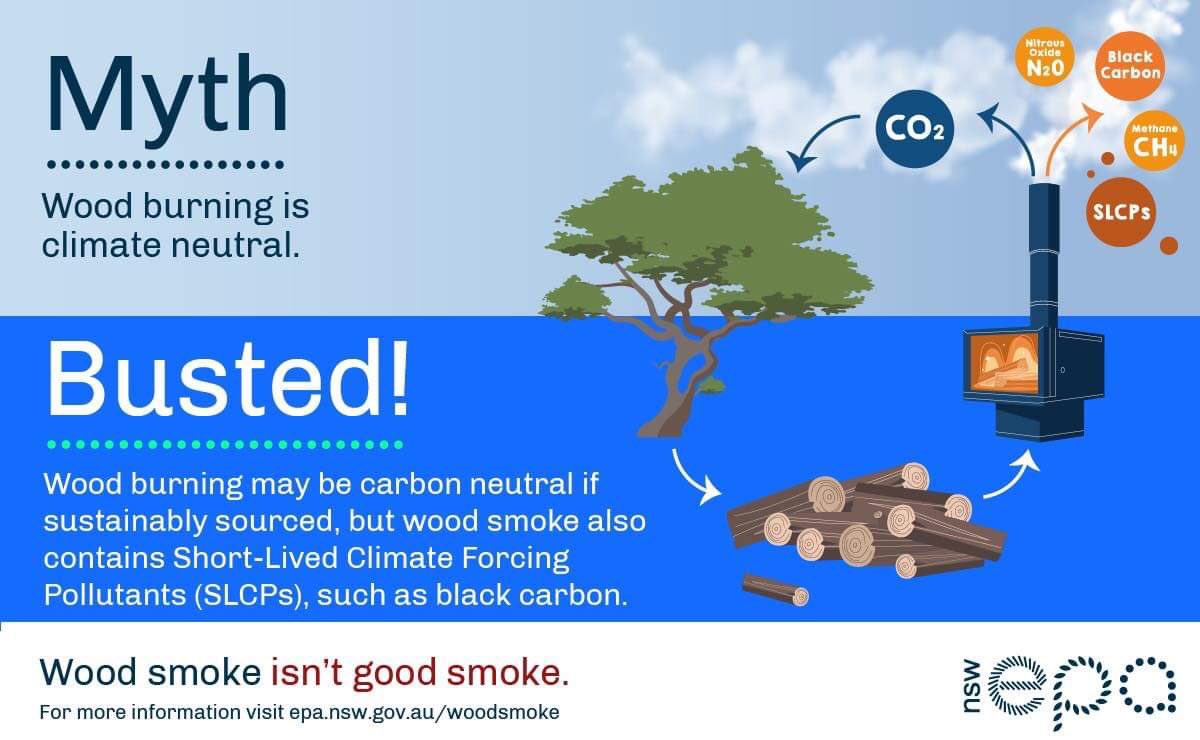
But...changing names to things such things as SLCP's and saying wood burning may be carbon neutral if sustainably sourced is skirting around the fact that air pollution is Group 1 carcinogen - (WHO) and there is no safe level of particulate matter.
Check for the latest Regulations further down the page
Check further down the page for latest updates

Canberra to phase out wood heaters by 2045 after report finds 'no safe level of air pollution' - 25.8.2023
Let’s not sugar coat it, this is a disgusting result.
2045! In line with environmental recommendations?
CEO of Asthma Australia Ms Goldman said, ‘People with asthma and carers of children affected will be very relieved by this news…”
Interesting, eh? Asthmatics keep your will up to date!
But then why should people get rid of their wood heaters when Forestry (both gov’t and private) have huge smoky burns, councils and TFS have registered smoky burns, aboriginals have cool smoky burns, people with wood fire pits and wood barbeques burn, and people have back-yard smoky burns.
Everyone needs to know wood smoke can ruin anyone’s health not just susceptible groups…
“Every single disease that is non-communicable is impacted by air pollution.
It is not only involved in worsening diseases but in causing them, and new diseases that would not otherwise occur are happening because of air pollution” – Sir Stephen Holgate, National Clean Air Conference Nov. 20/21. Add to this COPD studies.
We have known since 2013 there is no minimum safe level when the WHO declared air pollution and PM2.5 to be both Group 1 carcinogens. Now some people seem happy to have another 20 years to act.
In the meantime, this long phase out time for wood heaters allows us to be sealed inside with portable air purifiers so the outdoor burning can continue. Stop the smoke at the source.
Portable air purifiers are noisy and draughty. Their specifications are calculated to be run at the highest speed which means people feel the need to turn their heating up higher which costs more. Portable purifiers take power to run and their filters cost money to change. They blow house dust around. They need to be in a sealed off room.
Who wants to live like this sealed up in your own home so smoke can continue for another 20+ years?
Let’s not sugar coat it, this is a disgusting result.
2045! In line with environmental recommendations?
CEO of Asthma Australia Ms Goldman said, ‘People with asthma and carers of children affected will be very relieved by this news…”
Interesting, eh? Asthmatics keep your will up to date!
But then why should people get rid of their wood heaters when Forestry (both gov’t and private) have huge smoky burns, councils and TFS have registered smoky burns, aboriginals have cool smoky burns, people with wood fire pits and wood barbeques burn, and people have back-yard smoky burns.
Everyone needs to know wood smoke can ruin anyone’s health not just susceptible groups…
“Every single disease that is non-communicable is impacted by air pollution.
It is not only involved in worsening diseases but in causing them, and new diseases that would not otherwise occur are happening because of air pollution” – Sir Stephen Holgate, National Clean Air Conference Nov. 20/21. Add to this COPD studies.
We have known since 2013 there is no minimum safe level when the WHO declared air pollution and PM2.5 to be both Group 1 carcinogens. Now some people seem happy to have another 20 years to act.
In the meantime, this long phase out time for wood heaters allows us to be sealed inside with portable air purifiers so the outdoor burning can continue. Stop the smoke at the source.
Portable air purifiers are noisy and draughty. Their specifications are calculated to be run at the highest speed which means people feel the need to turn their heating up higher which costs more. Portable purifiers take power to run and their filters cost money to change. They blow house dust around. They need to be in a sealed off room.
Who wants to live like this sealed up in your own home so smoke can continue for another 20+ years?
ABC Mornings - Prof Fay Johnston
July 2023 - CSIRO study says to use air purifyers
for plannedburns and wood heater smoke
Cleanairtas maintains portable air purifiers can be noisy and draughty. Their specifications are calculated to be run at the highest speed which means people feel the need to turn their heating up higher – which costs more. Portable purifiers take power to run and their filters cost money to change. They need to be in a sealed off room. Purifiers should not be used to allow deliberate burning.
Any smoke must be stopped at the source!
Stop trying to lock us up so needless burning can continue.
for plannedburns and wood heater smoke
Cleanairtas maintains portable air purifiers can be noisy and draughty. Their specifications are calculated to be run at the highest speed which means people feel the need to turn their heating up higher – which costs more. Portable purifiers take power to run and their filters cost money to change. They need to be in a sealed off room. Purifiers should not be used to allow deliberate burning.
Any smoke must be stopped at the source!
Stop trying to lock us up so needless burning can continue.
Launceston - Call for greater focus on air pollution
7.9.2023 ABC radio - AM
7.9.2023 ABC radio - AM
